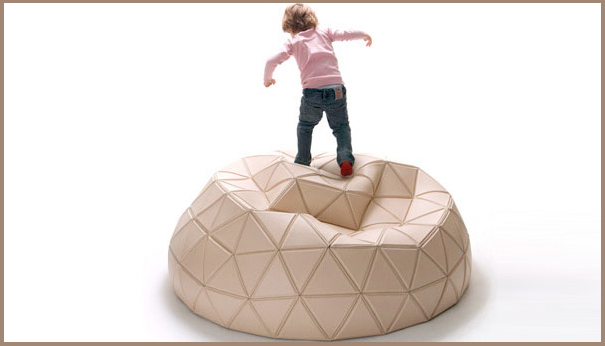Deconstructing the Dome: Bucky’s Nightmare by Mathieu Lehanneur
Paris-based designer Mathieu Lehanneur simultaneously honors and impugns the famed architect and kook Buckminster Fuller with his recent creation, parodically entitled “Bucky’s Nightmare.” Lehanneur’s piece of furniture reinterprets the geodesic dome, which although not created by Buckminster Fuller, was patented and popularized by him (credit for the invention of the geodesic dome goes to Walther Bauersfeild). To adequately understand Lehanner’s object, it is necessary to know something of the mastermind behind its inspiration.
Bucky’s Nightmare. Designed by Mathieu Lehanneur.
Harvard drop-out (actually he was kicked out twice, once for hosting a group of traveling dancing girls, then for displaying apathy), Buckminster “Bucky” Fuller became an inventor, philosopher, architect, artist, environmental activist, and guru. Fuller was so well-known for his geodesic domes that he was memorialized for them when scientists renamed fullerenes buckyballs (the carbon molecules resemble geodesic spheres). While geodesic domes and spheres have inspired architectural wonders the world over, they are more often associated with unstable personalities—the type of people living out in the middle of nowhere drawing water from magic springs in order to hydrate their aliens. But Fuller’s idiosyncrasies should not negate his contributions to the world, especially in the fields of art and architecture (on the other hand, if you’re interested in Fuller’s particular brand of crazy, check out his now-defunct artistic commune Drop City and his 1970 book I Seem to be a Verb).


Lehanneur’s “chair” pays homage to Fuller. On the designer’s website, he states, “Buckminster Fuller stands for science fiction made into real architecture.” If Lehanneur intends to commemorate Fuller, then why is his creation labeled “Bucky’s Nightmare”? The answer is simple: Bucky’s Nightmare “deflates tensegrity to kick research into blob structures.” As you might have surmised, tensegrity is vital to a successful geodesic dome, so its deflation would necessarily disturb the dead Fuller. However, I would argue that Bucky’s Nightmare, like all true parodies, praises its predecessor even as it deconstructs and recreates. Lehanneur’s “biomorph leather island” adapts to the human body at every turn, supporting weight in inventive ways. And as it conforms to the homonid form, Bucky’s Nightmare shifts into different shapes, making the furniture a three-dimensional art object in its own right. Mathieu Lehanneur has concocted a fluctuating and commutative piece, proving what Buckminster Fuller said about designers: “A designer is an emerging synthesis of artist, inventor, mechanic, objective economist and evolutionary strategist.”




Leave a Reply